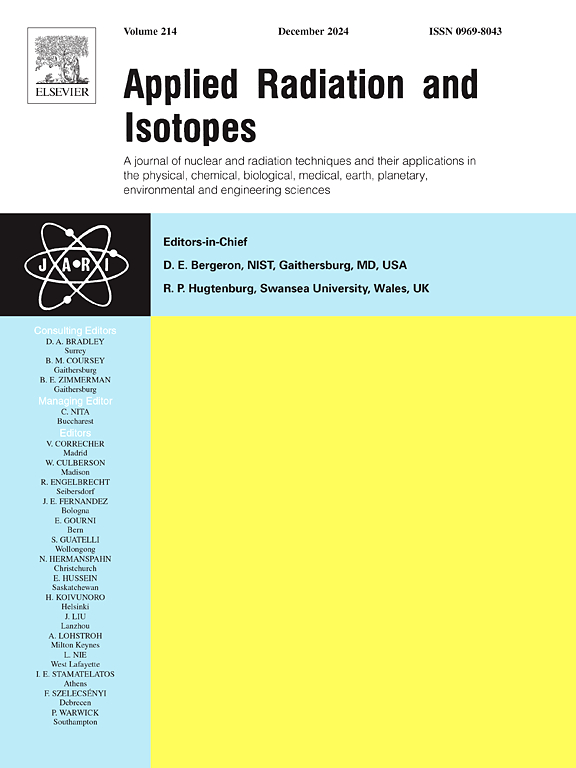研究核医学成像暴露条件下LaCl3:Ce和LaBr3:Ce闪烁体散射辐射扩散的影响
IF 1.8
3区 工程技术
Q3 CHEMISTRY, INORGANIC & NUCLEAR
引用次数: 0
摘要
晶体闪烁体材料被用作辐射探测系统的一部分。它们的高原子序数和将电离辐射转化为光子的效率提高了探测器的灵敏度。晶体闪烁体的一个重要应用是核医学成像探测器。在这类设备中,散射辐射的扩散可能会影响初始相互作用位置横向区域的信号,导致图像退化。最近LaCl3:Ce和LaBr3:Ce闪烁体作为混合SPECT/CT探测器系统的候选体进行了研究。这项工作的范围是通过蒙特卡罗模拟,从理论上检查用于核医学成像应用的LaCl3:Ce和LaBr3:Ce闪烁体的散射辐射。结果表明,闪烁体厚度越厚,其出口附近的散射分量越高,但离闪烁体中心轴点的距离没有显著值。LaBr3:Ce在140 keV辐照条件下的最大值。本文章由计算机程序翻译,如有差异,请以英文原文为准。
Examining the effect of scatter radiation spread in LaCl3:Ce and LaBr3:Ce scintillators under nuclear medicine imaging exposure conditions
Crystalline scintillator materials are used as part of a radiation detection system. Their high atomic number and their efficiency in converting ionizing radiation to optical photons increase the sensitivity of the detector. An important application of crystalline scintillators is in nuclear medicine imaging detectors. In such equipment scatter radiation spread may affect the signal in areas lateral to the initial interaction site, resulting in image degradation. Recently LaCl3:Ce and LaBr3:Ce scintillators have been studied as candidates for a hybrid SPECT/CT detector system. The scope of this work is to theoretically examine the scatter radiation of LaCl3:Ce and LaBr3:Ce scintillators for nuclear medicine imaging applications, through Monte Carlo simulations. It was found that the higher the thickness of the scintillator the higher the scatter component near its exit, although no significant values were calculated for distances further than that from the central axis point of the scintillator. The highest values were calculated for LaBr3:Ce under 140 keV irradiation conditions.
求助全文
通过发布文献求助,成功后即可免费获取论文全文。
去求助
来源期刊

Applied Radiation and Isotopes
工程技术-核科学技术
CiteScore
3.00
自引率
12.50%
发文量
406
审稿时长
13.5 months
期刊介绍:
Applied Radiation and Isotopes provides a high quality medium for the publication of substantial, original and scientific and technological papers on the development and peaceful application of nuclear, radiation and radionuclide techniques in chemistry, physics, biochemistry, biology, medicine, security, engineering and in the earth, planetary and environmental sciences, all including dosimetry. Nuclear techniques are defined in the broadest sense and both experimental and theoretical papers are welcome. They include the development and use of α- and β-particles, X-rays and γ-rays, neutrons and other nuclear particles and radiations from all sources, including radionuclides, synchrotron sources, cyclotrons and reactors and from the natural environment.
The journal aims to publish papers with significance to an international audience, containing substantial novelty and scientific impact. The Editors reserve the rights to reject, with or without external review, papers that do not meet these criteria.
Papers dealing with radiation processing, i.e., where radiation is used to bring about a biological, chemical or physical change in a material, should be directed to our sister journal Radiation Physics and Chemistry.
 求助内容:
求助内容: 应助结果提醒方式:
应助结果提醒方式:


